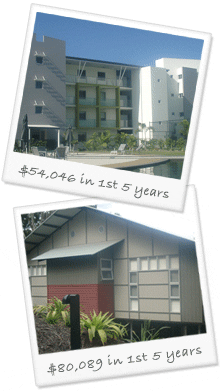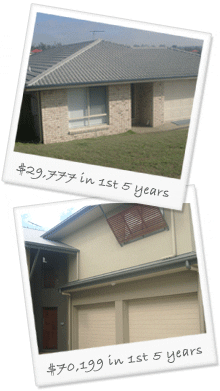What is Tax Depreciation & How do Residep Reports best reflect this?
From 20th July 1982 (Commercial) and from 18th July 1985 (Residential), Investment properties are eligible for depreciation entitlements/depreciation allowances. These entitlements and allowances relate to cost.
Both Diminishing Value Method and the Prime Cost Methods are applicable and our reports show each method separately, enabling the recipient the discretion to select the most appropriate method for them. Depreciation rates used in our schedules are taken from those recommended in legalisation at the time the property was acquired.
Our Reports
Our report has a Capital Expenditure summary, which summarises the three relevant categories:
Division 40 – Capital allowances for expenditure on plant
The plant listed in our schedules comply with the current list of depreciable assets made available by the Commission of Taxation which qualify under Division of the Income Tax Assessment Act 1997.
The depreciation rates used are in accordance with legislation current at the date of the schedule being produced. All plant listed in our reports is identified during an on-site inspection and has been valued as an appointment of the total capital expenditure analysed. Typically the depreciation rates range from 5% to 100% depending on the item and the cost. Some assets may qualify as an ‘immediate write-off’ (if the cost is less than $300).
Low Value Pooling Assets with a cost of less than $1000 can be written off at a rate of 18.75% in the first year (irrelevant of days owned) and 37.5% in the subsequent years. (Mindful that Low Value Pooling is only applicable to the Diminishing Value Method of depreciation).
Division 43 – Capital Works deductions on structures and infrastructure
Capital Allowances are derived from Division 43 of the Income Tax Assessment Act 1997 deductions for Capital Works. The qualifying expenditure is based on the historical cost of construction of the asset at the time of construction, with the exclusion of plant and ineligible items.
For Residential, Building Allowances between 18th July 1985 to 15th September 1987 was 4% per annum, while from 16th September 1987 to present Building Allowances is 2.5% per annum. (Structural Improvements is 2.5% from 27th Feb 1992).
For Non-Residential, Capital Allowance between 20th July 1982 to 21st August 1984 was 2.5%, while from 22nd August 1984 to 15 September 1987 was 4% and from 16th September 1987 to present is 2.5%.
Balance of Capital Expenditure (land values and ineligibles)
This represents all items that do not qualify for taxation depreciation. This includes the land value and any ineligible Capital Works associated with the property.
Our reports then show a Summary of Property Allowances – our reports show the full 40-year time horizon of the investment.
One section shows the Summary of Claim by using the Diminishing Value Method, showing separate columns for Depreciation on Plant, Low Value Pooling, Capital Allowances and Yearly Total.
The other section shows the Summary of Claim by using the Prime Cost Method, showing separate columns for Depreciation on Plant, Capital Allowances and Yearly Total.
(The yearly totals for each method balance).
Following on through the balance of the report, are all the individually itemised plant and articles, with applicable depreciation rates, using effective lives as stated in TR 2000/18.
Total Cost, Depreciation Rate, Pro-rate depreciation for part of first year held and Written Down Values are shown separately.
Capital Expenditure Incurred on Qualifying Building Allowance, and Qualifying Structural Improvements are shown separately with itemised Historical Cost, Depreciation Rate, Annual Claim, Opening Residual Value, Total Capital Allowances for 365 days and opening Written Down Value
An example of our reports is availible for you. Click here to view.
Post Purchase Addendum
Our schedules now incorporates Post Purchase Additions, as well as existing Pre Purchase Renovations/ Additions!
Post Purchase Expenditure is referred to as assets purchased after settlement and that are not included in the original purchase price of the property. The assets may in some cases have different purchase (start) dates.
We include the Post Purchase Expenditure in the report as an addendum table. Expenditure is listed by item, date, applicable depreciation rate and then summarised into yearly total claimables.
View a copy of the Post Purchase Addendum here.



